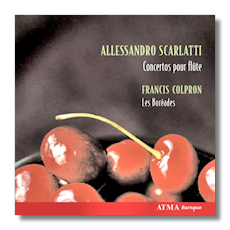
The Internet's Premier Classical Music Source
Related Links
- A. Scarlatti Reviews
- Latest Reviews
- More Reviews
-
By Composer
-
Collections
DVD & Blu-ray
Books
Concert Reviews
Articles/Interviews
Software
Audio
Search Amazon
Recommended Links
Site News
 CD Review
CD Review
Alessandro Scarlatti

Concerto for Flute
- Sonata (Concerto) #23 in C Major for Recorder, 2 Violins & Continuo
- Sonata (Concerto) #24 in G minor for Recorder, 2 Violins & Continuo
- Sinfonia in G Major for Recorder & Continuo
- Sonata (Concerto) #12 in C minor for Recorder, 2 Violins & Continuo
- Sonata in F Major for 3 Flutes & Continuo
- Sonata (Concerto) #21 in A minor for Recorder, 2 Violins & Continuo
- Concerto in F Major for Recorder, 2 Violins & Continuo
- Sonata (Concerto) #9 in A minor for Recorder, 2 Violins & Continuo
Francis Colpron, recorder
Les Boréades/Francis Colpron
Atma Classique ACD2-2521 DDD 61:10
A little linguistic confusion shouldn't keep one from hearing this delightful disc. The Atma Classique label is based in Québec, and the cover promises "Concertos pour flûte," which most English-speakers would assume to mean "flute concertos." Turning to the inlay card, however, we read that Francis Colpron plays the "flûte à bec," which is how French-speakers describe the recorder. (What the English simply call the flute, the French call the "flûte traversière" or "transverse flute.") So, in other words, this is a CD of works for recorder, not flute. It is worth mentioning that it isn't really clear which instrument Scarlatti meant these works to be played on anyway; they can be played on either flute or recorder.
Also, you will note that five of the works are designated "Sonata (Concerto)." This seeming contradiction is explored in ATMA's booklet note. By the time Scarlatti wrote these works (circa 1725), Vivaldi already had developed what might be thought of as the "standard" concerto – a three-movement work in which one or more soloists are in dialogue with an ensemble (tutti). Scarlatti's works are in four or five movements, however, and the contrast between the soli and the tutti is hardly as pronounced as it is in Vivaldi's concertos. Still, these works are identified as concertos in the contemporary manuscripts. A better term, however, might be "sonata" – more specifically, "chamber sonata," although the movements are not patterned after dances, or "church sonata," although they do not seem to have been intended for performance in a church. "Sonata à quattro" ("sonata for four"), while dullest, might be the most accurate name.
Does it matter? Not to me. Scarlatti, like Mozart, might have cared little for the flute (or the recorder), but he (again, like Mozart) put his best foot forward when he was asked to compose music for it. These works, even those in a minor key, radiate warmth and contentment, and in the sonata for three recorders, there's a slightly giddy good-humor in action. The slow movements are not deep, but they are no less beguiling than the faster ones, and the faster ones chirp gently, like birds incubating their eggs.
Soloist Francis Colpron contradicts Scarlatti's complaint to Quantz (probably the recipient of several of these works) that wind instruments never are in tune. Colpron hits each note in its center, although "hit" might be the wrong word to use with playing as mellifluous as this. While his playing is sweet, it's sufficiently alert and varied to avoid any hint of dullness. The Baroque ensemble Les Boréades complements him with similar virtues. The basso continuo instruments include guitar or chittarone, and harpsichord or organ, further increasing the imaginative variety of these performances.
This is a lovely disc, and not just if you enjoy the recorder.
Copyright © 2008 by Raymond Tuttle




















